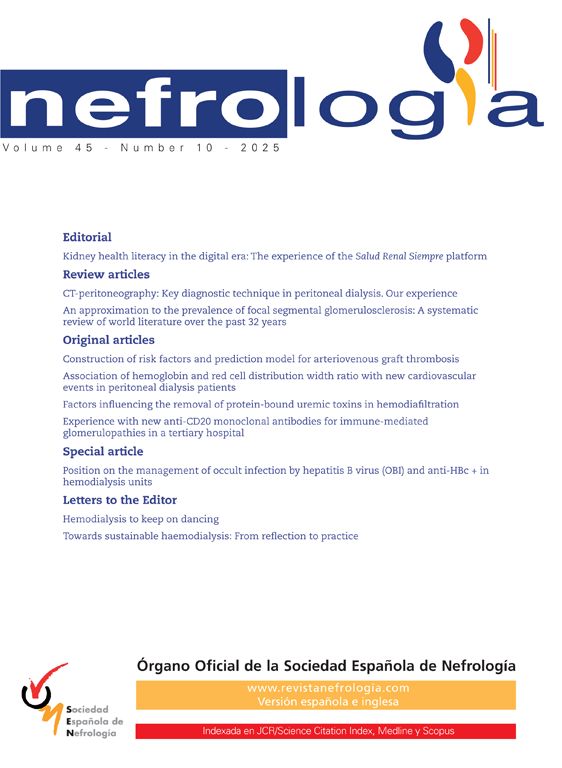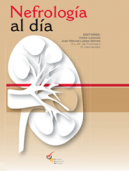INTRODUCTION
In the most recent update of the K/DOQI Guidelines on vascular access (VA), regular measurement of blood flow (QA) in AV continues to be the preferred method for functional monitoring of VA.1 Since 1995, several screening procedures based on indirect QA measurement have been introduced for non-invasive VA monitoring.2-4 One of these is the thermodilution technique (TDT), a method that allows calculation of QA from the recirculation values obtained by the blood temperature sensor called BTM (Blood Temperature Monitor) with the hemodialysis (HD) lines in the normal and reverse positions.5 This procedure, described and validated by Schneditz et al,6 is easy to perform because the BTM sensor is integrated into the HD machine.
On the other hand, our department implemented in June 2000 a VA monitoring program consisting of regular measurement of QA during HD using the Delta-H method.7 The purpose of this monitoring is early diagnosis of a 50% or greater stenosis of the vascular lumen and elective correction of stenosis by angioplasty or surgery before VA thrombosis occurs.8 During the years of use, this monitoring program has been shown to be effective both for early diagnosis of significant VA stenosis (the Delta-H method has sensitivity and specificity higher than 80%) and for reduction of thrombosis prevalence.3,7 In this regard, Wang et al showed that the recirculation values obtained with the BTM sensor provided a high sensitivity (81.8%) and specificity (98.6%) for detection of arteriovenous fistula (AVF) amenable to elective surgery.9
This was an observational, cross-sectional, comparative study using TDT aimed at measuring QA in VA during HD,
analyze different variables that may have an impact on VA function, and perform a comparative functional study of the TDT and Delta-H methods.
MATERIAL AND METHODS
Patients
VA was monitored in 38 patients with renal failure on a chronic HD program. All patients underwent HD three times a week at the nephrology department of Hospital de Mollet through an indwelling VA cannulated by two puncutres. Patients with any previously documented sign of VA dysfunction were excluded. Variables analyzed included sex, age, primary nephropathy, time on HD, history of any comorbidity other than diabetes mellitus (ischemic heart disease, cerebrovascular disease, or peripheral artery disease), Kt/V index (by second-generation Daugirdas formulas, monocompartmental model), VA type, VA duration, history of prior VA, VA number/patient ratio. Table I summarizes the most significant characteristics of patients entering the study.
Method
1) QA measurement by TDT. QA was measured using the blood temperature sensor, BTM, incorporated into the Fresenius Medical Care model 4008-S machine. This dilution method, described and validated by Schneditz et al,6 calculates QA from the recirculation values obtained with the HD lines in the normal and reverse positions. The measurement process starts from the production of a «temperature bolus» secondary to the self-limited decrease (2ºC for 2 minutes) in the temperature of the dialysis fluid. This thermal decrease is initially sensed by the temperature sensor of the venous line, and after traveling through the cardiopulmonary circulation of the patient, returns already reduced toward the dialyzer and is felt by the temperature sensor of the arterial line. Quantification
of the last «arterial temperature bolus» in relation to the «venous temperature bolus» initially generated allows for calculating the recirculation percentage with the HD lines in a normal configuration. The same procedure is repeated with HD lines in a reverse configuration. QA is calculated from both recirculation values using the following formula (Otro T 1,2,3,4 - F 1) where QS is the effective blood flow (mL/min), UFR the ultrafiltration rate (mL/min), RN is recirculation obtained with the HD lines in normal position, and RX is recirculation obtained with HD lines in reverse position. For adequate recirculation values to be obtained, both QS and UFR should be kept constant throughout measurement. QA was measured in duplicate during the first hour of 2 consecutive HD sessions, and the 2 values recorded were averaged. The distance between needles (DBN) and mean arterial pressure (MAP) (diastolic blood
pressure + 1/3 of pulse pressure) were also recorded in both sessions.
2) QA measurement by the Delta-H method. QA was again measured within 15 days by the optodilutional Delta-H method, using the Crit-Line III monitor (ABF-mode, HemaMetrics, USA) in most patients (36/38, 94.7%). The Delta-H method could not be used in 2 cases because of kidney transplant and an acute coronary syndrome that required admission to the coronary unit respectively. This method, described and validated by Yarar et al,10 is a photometric technique based on the reverse relationship existing between volemia and arterial hematocrit (Hct). QA was also measured during the first hour of HD dialysis from Hct changes related to sharp changes in UF (from 0.1 to 1.8 L/h) with HD lines in a normal or reverse configuration. Hct changes are continuously recorded by an optic sensor coupled to a blood chamber that is inserted between the dialyzer and arterial line. QA was calculated using the following formula:
QA= (max UF - min UF) · max rev Hct/rev Hct Δ - nor Hct Δ
where max UF is maximum ultrafiltration, min UF is minimum ultrafiltration, max rev Hct is the maximum Hct obtained with HD lines in a reverse position, rev Hct Δ is the change in arterial Hct with reversed lines, and nor
Hct Δ is the change in arterial Hct with HD lines in normal position.
All measurements by both procedures were performed by the same investigator.
Statistical study
Statistical data analysis was performed with SPSS software version 12.0 for Windows. Values are given as percentages or as mean ± standard deviation. The study comparing mean QA in VA between certain patients subgroups compared two by two was performed using a t test for two independent samples and a non-parametric Mann-Whitney¿s U test. APearson¿s correlation coefficient was calculated for the correlation analysis between mean QA in VA and the different quantitative variables studied. A diagnostic agreement analysis was done by calculating the intraclass correlation coefficient between blood flow values in the VA measured by the Delta-H and TDT methods (fixed factor) on the same patient sample (random factor). A value of p < 0.05 was considered statistically
significant.
RESULTS
Mean QA measured by TDT was 1,170.5 ± 464.2 mL/min (range, 289.4-2,346.4 mL/min). Most VAs (44.7%) had a
mean QA ranging from 1,000 and 1,500 mL/min (table II). Mean DBN and MAP were 6.2 ± 2.9 cm and 91.9 ± 12.4
mmHg respectively.
Table III shows 10 different variables based on the mean QA recorded. QA was similar for both patients with MAP values both lower or higher than 100 mmHg (p = NS). Patients with diabetic nephropathy had a significantly lower QA (836.1 ± 395.8 mL/min) as compared to all other patients (1,245.9 ± 449.9 mL/min) (p = 0.033). No differences were found in mean QA when patients with any comorbidity other than diabetes and with no comorbidities were compared (p = NS). A trend was noted to a higher QA in the brachial AVF as compared to the radial AVF (1,323.6 ± 465.3 versus 1,017.4 ± 447.3 mL/min) (p = 0.052). Patients with a history of prior VAhad a significantly higher mean QA (1,410.6 ± 377.7 mL/min) as compared to all other patients (1,030.4 ± 458.7 mL/min) (p = 0.013).
No correlation was found between mean QA and the following variables: age (r = -0.25, p = 0.13), DBN (r = -0.08, p = 0.61), MAP (r = -0.021, p = 0.90), Kt/V index (r = 0.078, p = 0.64), time on HD (r = 0.29, p = 0.07), and VA duration (r = -0.023, p = 0.89).
Mean QA measured by TDT was similar to the mean blood flow measured using the Delta-H method (1,151.3 ± 479.0 mL/min) in 36 patients (p = 0.89). Blood flow values in the VA recorded by TDT significantly correlated to those measured using the Delta-H method (intraclass correlation coefficient = 0.95, p < 0.001). The Bland-Altman plot in figure 1 shows the agreement between both procedures.
DISCUSSION
QA values measured by TDT are very similar to those reported in other series by different authors using different non-invasive methods to calculate QA. Table IV shows some of these methods, selected based on the greater prevalence of AVF, which is the type of VA most prevalent in our setting.16
In this study, a significant difference was found in VAfunction between patients with diabetic nephropathy and all other patients. Diabetic patients had a lower QA (< 1,000 ml/min) as compared to all other patients, though sufficient to ensure adequate dialysis. This functional difference may be explained by the greater prevalence of vascular calcifications in diabetic patients.17,18 In this regard, in the multivariate study conducted by Tonelli et al, in which 4,084 QA measurements were performed in 294 patients with AVF using the ultrasound dilution method, diabetes mellitus was, together with overweight and systolic blood pressure, a variable independently associated
to QA, so that AVF function was always significantly lower in diabetic patients (788 ± 580 versus 1,054 ± 681
mL/min)19. This functional impairment may result in a decreased VA survival in diabetic patients.16,20,21 In Spain, according to data from the Registre de Malalts Renals de Catalunya, in addition to patient age and time on dialysis, diabetes mellitus is one of the factors having a negative impact on VA duration.16
In most cases, maturation of a more proximal secondary AVF is promoted by venous changes resulting from a previously functioning ipsilateral VA.22,23 In this study, VA function was better in patients with history of a prior VA. Existence of a prior venous arterialization in most of these patients (78.6%) may account for this functional difference. That is, history of a functional VA located more distal in the same limb may condition function of a new proximal secondary AVF. In this regard, in the Begin et al series including 45 patients with AVFs, QA values of patients with brachiocephalic AVF, as measured by the ultrasound dilution method, were higher in patients with history of a previously functioning radiocephalic AVF in the same arm than in those with no such history (1,800 ± 919 versus 1,167 ± 528 mL/min)12
Our study demonstrated the functional agreement between the TDT and Delta-H methods. No significant differences
were found between the VA blood flow values recorded by both procedures. Other authors reported similar results after comparing blood flow values in VAmeasured by TDT and the ultrasonic dilution method.6,14 In fact, in the initial series of Schneditz et al, comprising 18 VAs (only 33.3% AVFs), the QA value recorded by TDT was 1,328 ± 627 mL/min, very similar to the value found by ultrasonic dilution, 1,390 ± 657 mL/min.6 In the more recent Wijnen et al series, involving 40 Vas /65% AVFs), no difference was found in the QA values measured by the ultrasonic dilution and TDT methods (1,053 ± 495 y 1,034 ± 527 mL/min, respectively).14
The functional comparison between the Delta-H and TDT methods could be considered as a limitation of this study, because most comparative functional studies conducted used the ultrasound dilution method as the reference procedure. However, the efficacy of the Delta-H method for VA monitoring has already been adequately documented.3,7 Moreover, according to the recent European Guidelines on vascular access, no clear preference exists for any of the reported procedures for measuring QA.24
The Impact Factor measures the average number of citations received in a particular year by papers published in the journal during the two preceding years.
© Clarivate Analytics, Journal Citation Reports 2025
SRJ is a prestige metric based on the idea that not all citations are the same. SJR uses a similar algorithm as the Google page rank; it provides a quantitative and qualitative measure of the journal's impact.
See moreSNIP measures contextual citation impact by wighting citations based on the total number of citations in a subject field.
See more




